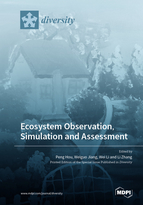Ecosystem Observation, Simulation and Assessment
A special issue of Diversity (ISSN 1424-2818). This special issue belongs to the section "Biodiversity Conservation".
Deadline for manuscript submissions: closed (31 October 2022) | Viewed by 30217
Special Issue Editors
Interests: ecosystem monitoring and assessment; ecology and environment of remote sensing; ecosystem protection; nature reserves and national parks
Special Issues, Collections and Topics in MDPI journals
Interests: remote sensing for ecosystems;spatial ecosystem simulation;ecosystem risk and sustainability assessment
Special Issues, Collections and Topics in MDPI journals
Interests: wetland restoration; wetland ecological processes and effects; wetland ecology of hyperspectral remote sensing
Interests: ecosystem modelling; terrestrial carbon cycle model–data fusion; ecosystem assessment
Special Issue Information
Dear Colleagues,
Ecosystem observation, simulation and assessment have always been vital in the field of ecology. In recent years, with the progress of science and technology, ecosystem observation methods and instruments have been developing rapidly, and there are increasing numbers of ground observation networks and earth observation satellites. At the same time, with the enhancement of the stress effects of climate change and human disturbance on the natural ecosystem, the ecosystem at global and regional scales is changing. Whether from the perspective of ecology itself or the sustainable development of human society, the simulation and evaluation of the ecosystem state and its changing characteristics are a key research focus. This Special Issue is intended to provide a platform for academic exchange regarding progress in ecosystem observation, simulation and evaluation. Specifically, studies including, but not limited to, the following topics are welcome:
- Ecosystem observation, monitoring, etc.;
- Ecosystem models and process simulation;
- Assessment of ecosystem functions, services and patterns;
- Species habitat protection and assessment;
- Nature reserves, national parks, and ecological space protection;
- Ecosystem management and regulation;
- Relationship between ecosystem evolution and climate change.
Prof. Dr. Peng Hou
Prof. Dr. Weiguo Jiang
Prof. Dr. Wei Li
Dr. Li Zhang
Guest Editors
Manuscript Submission Information
Manuscripts should be submitted online at www.mdpi.com by registering and logging in to this website. Once you are registered, click here to go to the submission form. Manuscripts can be submitted until the deadline. All submissions that pass pre-check are peer-reviewed. Accepted papers will be published continuously in the journal (as soon as accepted) and will be listed together on the special issue website. Research articles, review articles as well as short communications are invited. For planned papers, a title and short abstract (about 100 words) can be sent to the Editorial Office for announcement on this website.
Submitted manuscripts should not have been published previously, nor be under consideration for publication elsewhere (except conference proceedings papers). All manuscripts are thoroughly refereed through a single-blind peer-review process. A guide for authors and other relevant information for submission of manuscripts is available on the Instructions for Authors page. Diversity is an international peer-reviewed open access monthly journal published by MDPI.
Please visit the Instructions for Authors page before submitting a manuscript. The Article Processing Charge (APC) for publication in this open access journal is 2600 CHF (Swiss Francs). Submitted papers should be well formatted and use good English. Authors may use MDPI's English editing service prior to publication or during author revisions.
Keywords
- ecosystem observation
- ecosystem simulation
- ecosystem assessment
- ecosystem protection
- nature reserves
- species habitat protection
- ecosystem management
- climate change









